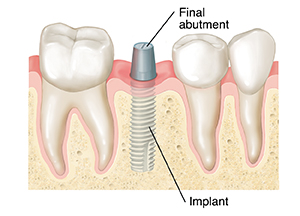Dental Implants: Placing Abutments and Making Your Prosthesis
If you have one or more missing teeth, your dentist may advise dental implants. A dental implant is an artificial tooth root. Your jawbone fuses with the implant to provide a secure platform for an artificial tooth (prosthesis). Abutments are connecting pieces that join the prosthesis to the implants. You may need an abutment and a prosthesis as part of your treatment.
Understanding abutments
Healing abutments (also called healing cuffs or caps) help gum tissue heal around the implant site. Once the gum has healed, final abutments are placed so the prosthesis can be joined with the implant. Abutments can be placed at the same time as the implant (one-stage surgery) or they can be placed during a second surgery following implant placement (two-stage surgery).
 |
| The top of the abutment sticks out just above the gum line. |
How abutments are placed
-
Exposing the implant. If you have a second surgery to place abutments, a small incision is first made in the gum tissue.
-
Placing healing abutments. In many cases, a healing abutment is temporarily secured to the implant.
-
Placing final abutments. When gums have healed, the final abutment is placed after an impression is taken.
After abutments are placed
It usually takes 4 to 6 weeks for gums to heal around abutments. During that time, follow your surgeon’s advice about what kinds of foods to eat. You will also be given instructions for cleaning around the abutments. Correct cleaning prevents infection and promotes healing.
When to call your dentist
After abutments are placed, call your surgeon if you have any of the following:
-
Bleeding that won’t stop
-
Pain in the jaws, mouth, or sinuses that isn’t relieved by prescribed medicine
-
A fever over 100.4ºF ( 38ºC)
-
An abutment that feels loose
Making your prosthesis
The implant then fuses to the bone, a process called osseointegration. Your restorative dentist will begin making your permanent prosthesis. This may take several weeks. You may need several office visits to receive your prosthesis. First, your dentist will temporarily replace your healing cap with a special abutment called a transfer coping. This gets attached to the implant with a screw. Then your dentist is ready to take a final impression. A model of your mouth can be made, showing the lab exactly where the implant is located.
-
A custom fit. To custom-fit the prosthesis, your restorative dentist will make molds (impressions) of your jaws, teeth, and abutments. Bite registrations are also made to see how your teeth fit together. These molds are used to create a model of your mouth. Your new prosthesis is then made on this model.
-
Fitting your prosthesis. Once the prosthesis is ready, you’ll have several fittings to see how it feels in your mouth. With a fixed prosthesis, this process may take a little longer. After any needed adjustments are made, the prosthesis is attached to the abutments. You may be told not to eat hard or crunchy foods for a few weeks after the prosthesis is attached.
When to call your dentist
After your prosthesis is attached, call your restorative dentist if you have any of these problems:
-
Pain in the jaws
-
A bite that feels wrong
-
A prosthesis that feels loose, chips, or breaks
-
Implants or abutments that feel loose